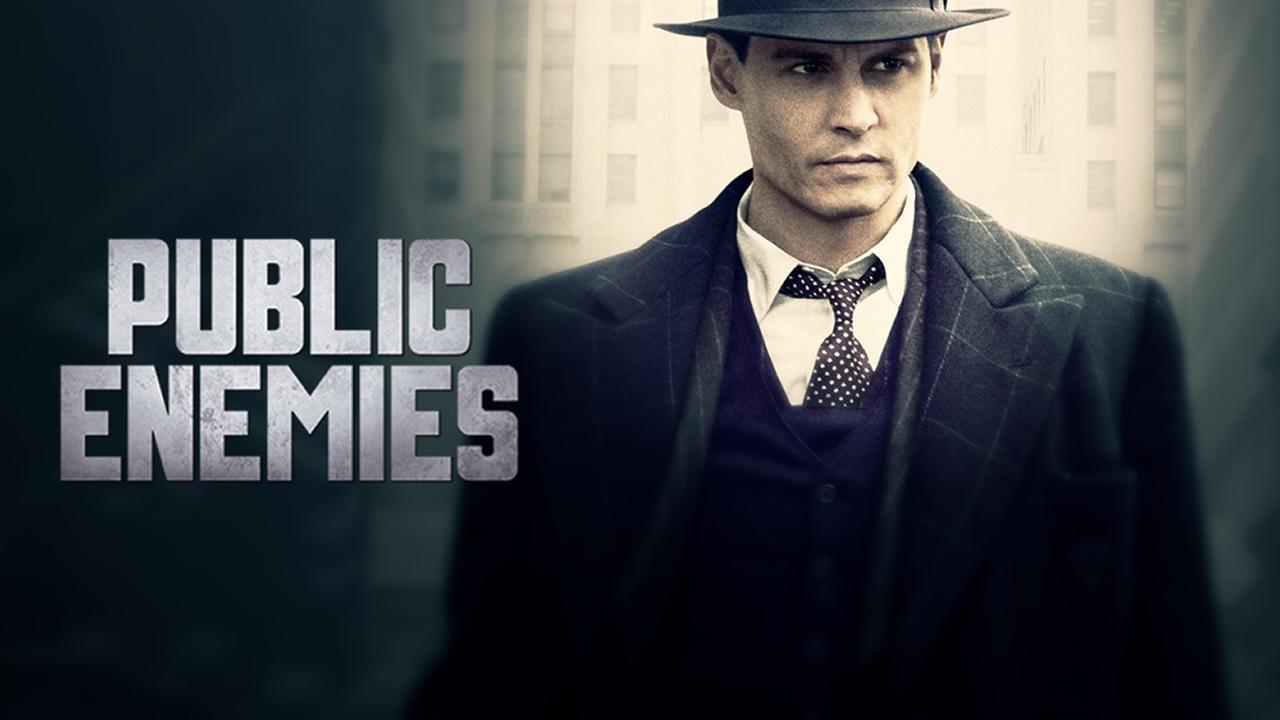Public Enemies (2009) – A Thrilling Tale of Crime, Betrayal, and Pursuit

Public Enemies (2009) – A Thrilling Tale of Crime, Betrayal, and Pursuit
Public Enemies (2009), directed by the masterful Michael Mann, is a electrifying crime drama that plunges viewers into the gritty, chaotic world of the Great Depression. Adapted from Bryan Burrough’s nonfiction book Public Enemies: America’s Greatest Crime Wave and the Birth of the FBI, 1933–34, the film weaves a taut narrative around the real-life exploits of the infamous gangster John Dillinger (Johnny Depp) and the dogged FBI agent Melvin Purvis (Christian Bale) tasked with hunting him down. With its blend of historical intrigue, visceral action, and raw human emotion, Public Enemies captures the electric tension of the 1930s criminal underworld, spotlighting Dillinger’s reign as a charismatic yet ruthless bank robber and the relentless pursuit that defined his downfall. This is a tale of crime, betrayal, and pursuit—a cinematic rollercoaster that grips you from the opening frame and doesn’t let go until its tragic, inevitable end.
A Depression-Era Antihero
The film unfurls in 1933, deep in the throes of the Great Depression, a time when America’s economic collapse left millions destitute and disillusioned. Banks foreclosed homes, breadlines stretched for blocks, and trust in the system crumbled. Into this void stepped figures like John Dillinger, a bank robber whose audacious heists and daring escapes turned him into a folk hero for a public weary of institutional failure. Public Enemies opens with a bang—literally—as Dillinger orchestrates a prison break to free his gang, setting the tone for a story where lawlessness meets legend.
Johnny Depp’s Dillinger is a study in duality: charming yet cold-blooded, a man who robs banks with a smile and a Tommy gun. The film traces his meteoric rise, from small-time crook to Public Enemy Number One, as he masterminds a string of meticulously planned heists across the Midwest. His signature move—vaulting over bank counters with acrobatic flair—becomes a symbol of defiance, earning cheers from onlookers who see him as a Robin Hood sticking it to the fat cats. “We’re having too good a time today—we ain’t thinking about tomorrow,” he quips in one scene, embodying a live-for-the-moment ethos that resonates with a desperate nation.
Yet, Dillinger’s charisma masks a brutal edge. He’s not above shooting his way out of a jam or abandoning wounded comrades—traits Depp plays with a steely glint, making him an antihero who commands both admiration and dread. The public’s fascination, stoked by breathless newspaper headlines, only fuels his mythos, turning him into a Depression-era celebrity whose exploits sell papers as fast as they empty vaults. Mann frames this adulation against the era’s despair, asking: What makes a criminal a hero when the system fails?
The Hunter and the Hunted
Dillinger’s reign doesn’t go unchallenged. Enter Melvin Purvis, portrayed by Christian Bale with a quiet intensity that contrasts Depp’s flash. A Southern gentleman turned FBI agent, Purvis is handpicked by J. Edgar Hoover (Billy Crudup) to lead the charge against the nation’s burgeoning crime wave. Bale’s Purvis is methodical, by-the-book, and burdened by duty—a stark foil to Dillinger’s reckless abandon. Assigned to take down the gangster in 1933, Purvis transforms the hunt into a personal crusade, driven as much by justice as by the pressure from a fledgling FBI desperate to prove its worth.
The film casts their rivalry as a classic cat-and-mouse game, each move escalating the stakes. Purvis starts with old-school tactics—stakeouts, informants—but soon adapts, deploying wiretaps and coordinated raids as the FBI evolves under Hoover’s ambitious eye. A pivotal moment comes during the Little Bohemia shootout, a real-life 1934 clash at a Wisconsin lodge where Purvis’s team ambushes Dillinger’s gang. Mann stages it with ferocious energy—bullets shredding wood, muzzle flashes lighting the night—but Dillinger slips away, leaving Purvis humiliated and two civilians dead in the crossfire. “He’s taunting us,” Purvis mutters, his resolve hardening into obsession.
Their pursuit is more than a chase—it’s a clash of ideals. Dillinger thrives on chaos and freedom; Purvis represents order and control. Bale imbues Purvis with a stoic weariness, his crisp suits and clipped speech hiding the toll of a mission that costs lives and tests his moral compass. The tension builds toward a fateful showdown, one history buffs know ends outside Chicago’s Biograph Theater in July 1934. Mann keeps you guessing, though, letting the drama simmer until the final, gut-punching frame.
Love in the Line of Fire
Amid the gunfire and getaways, Public Enemies weaves a tender thread through Dillinger’s romance with Billie Frechette, played with soulful grace by Marion Cotillard. A coat-check girl with a hardscrabble past, Billie meets Dillinger in a Chicago nightclub, where his charm—“I like you, and I’m taking you with me”—sweeps her off her feet. Cotillard’s Billie is no damsel; she’s tough, witty, and fiercely loyal, a counterpoint to Dillinger’s icy exterior. Their chemistry crackles—stolen glances in smoky bars, a dance under dim lights—offering a glimpse of the man beneath the myth.
But love in Dillinger’s world is a liability. When Purvis’s men arrest Billie to lure him out, she endures interrogation with defiance, her arrest a heartbreaking pivot that deepens the film’s emotional stakes. Cotillard’s Oscar-worthy performance—fresh off her La Vie en Rose win—lends Billie a vulnerability that humanizes Dillinger, showing what he’s willing to risk for her. “I’ll come for you,” he promises, a vow he can’t keep as the noose tightens. Their doomed romance mirrors the film’s broader tragedy—freedom, even love, comes at a steep price in a world of betrayal and pursuit.
The Rise of the FBI
Public Enemies isn’t just Dillinger’s story—it’s a snapshot of law enforcement’s transformation. The 1930s marked the birth of the modern FBI, and Mann weaves this evolution into the narrative with historical heft. Billy Crudup’s J. Edgar Hoover is a small but pivotal presence—a shrewd, ambitious bureaucrat pushing to expand the Bureau’s power. “We need to be an army,” he declares in one scene, lobbying Congress for funds and authority to combat the likes of Dillinger, Baby Face Nelson, and Pretty Boy Floyd.
The film captures the FBI’s growing pains—understaffed, underfunded, and reliant on outdated methods until Hoover’s vision takes hold. Purvis’s journey reflects this shift: from chasing leads with a handful of agents to commanding a task force armed with radios and Tommy guns. Mann contrasts the gangsters’ anarchic flair with the FBI’s methodical rise, spotlighting real events like the Kansas City Massacre of 1933, which spurred federal crackdowns. It’s a subplot that grounds the action in history, showing how Dillinger’s spree forced a nation to rethink justice.
A Cinematic Time Machine
Visually, Public Enemies is a triumph, thanks to cinematographer Dante Spinotti’s masterful eye. Shot in high-definition digital—a Mann signature—the film marries crisp modernity with period authenticity. Natural lighting bathes scenes in a moody glow: the golden haze of a bank lobby, the stark shadows of a nighttime shootout. Locations like Chicago’s Union Station and the Little Bohemia Lodge, filmed on-site, immerse you in the 1930s, their Art Deco details and weathered textures evoking a bygone era.
The pacing is relentless—bank heists explode with rapid cuts, chases pulse with urgency, and quiet moments simmer with dread. Mann’s sound design amplifies the tension: the deafening roar of gunfire, the clack of typewriter keys, the distant wail of sirens. A standout sequence—the Biograph ambush—unfolds with surgical precision, Depp’s Dillinger sauntering out of a screening of Manhattan Melodrama only to meet his end in a hail of bullets. It’s a tragic crescendo that feels both inevitable and shocking, a testament to Mann’s knack for suspense.
Stellar Performances and Lasting Impact
The cast elevates Public Enemies beyond a mere crime flick. Johnny Depp’s Dillinger is magnetic—his boyish grin and steely gaze crafting a rogue you can’t look away from. Christian Bale’s Purvis is restrained yet riveting, a man buckling under duty’s weight. Marion Cotillard’s Billie steals every scene she’s in, her warmth piercing the film’s brutality. Supporting players—Stephen Lang as a grizzled agent, John Ortiz as a mob fixer—add depth, while cameos from real figures like Baby Face Nelson (Stephen Graham) nod to the era’s rogues’ gallery.
Released on July 1, 2009, Public Enemies earned $214 million worldwide against a $100 million budget—a solid hit, though critics were mixed (68% on Rotten Tomatoes). Some praised its style and stars; others found its 140-minute runtime bloated or its history too loose. Yet, it’s aged into a cult favorite, lauded for its raw energy and Mann’s uncompromising vision.
A Tale Worth Telling
Public Enemies is a must-watch for crime drama aficionados and history buffs alike—a brutal, honest, and thought-provoking plunge into fame, lawlessness, and the human hunger for freedom. It’s not just about Dillinger’s heists or Purvis’s pursuit; it’s about a nation at a crossroads, caught between rebellion and order. With stellar performances, rich historical context, and Mann’s visceral direction, the film delivers a thrilling ride that lingers long after the credits roll. In a world of betrayal and pursuit, Public Enemies asks: What’s the cost of living free when the law—and fate—close in?













